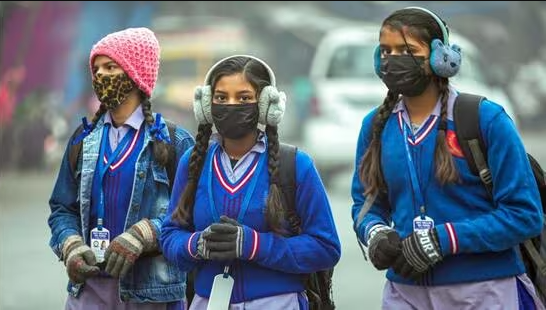
School students going to school on cold and foggy winter morning, in New Delhi, India, on Friday.
Latest ASER Data Reveals Dip in Language Skills, Slight Math Improvement
The Annual Status of Education Report (ASER) for 2023, titled “Beyond Basics,” released on Wednesday by Pratham Foundation, indicates that one in four individuals between 14 and 18 years old in rural India struggles to read a Class 2 level text in their native language fluently. Additionally, at least 42.7% face difficulties reading sentences in English. The report is based on a survey of 34,745 people in the specified age group across 28 districts in 26 states.
Despite an improvement in enrollment since the last survey in 2017, the data shows a slight drop in language skills and a marginal improvement in arithmetic abilities. The enrollment percentage stands at 86.8%, compared to 85.6% in 2017. However, enrollment decreases with age, with 3.9% of 14-year-olds, 10.9% of 16-year-olds, and 32.6% of 18-year-olds not currently enrolled in school or college.
Reasons for dropout differ between genders, with one in four boys attributing it to “lack of interest” and one in five girls citing “family constraints.” The report notes a positive trend in narrowing the gender gap, with a 4.1 percentage point gap in 2017 reduced to 0.2 percentage points in 2023.
Concerning foundational literacy and numeracy (FLN), the survey evaluated youth on four parameters: basic reading, math, and English abilities; application of basic skills to everyday calculations; reading and understanding written instructions; and real-life financial calculations. The findings reveal that 73.6% of 14-18 year-olds can read a Class 2 level text (compared to 76.6% in 2017), and 43.3% can perform a simple (Class 3-4 level) division problem (compared to 39.5% in 2017).
The report emphasizes the importance of addressing FLN deficits early, as students are unlikely to acquire these foundational skills later in their academic journey. It suggests focusing on teacher training and foundational literacy and numeracy programs for middle and high school students.
For the first time, ASER recorded the course stream of students in classes 11 and 12 and college. Results showed 54% enrolled in humanities, 33.4% in science, and 9.3% in commerce. Female students are less likely to enroll in STEM streams (28.1%) than male students (36.3%). The report underscores the need for “catch-up” efforts in foundational literacy and numeracy for a significant portion of the 14-18 population.
The survey also examined digital awareness, revealing that 90% of surveyed youth came from households with smartphones. Males are more likely to own smartphones, with 43.7% having their own compared to 19.8% of females. Digital proficiency remains a concern, and efforts are needed to address the digital gender divide through access and proficiency initiatives.
